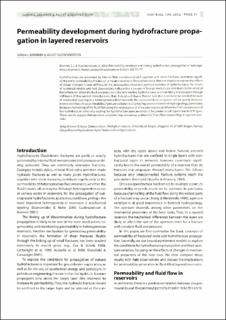Permeability development during hydrofracture propagation in layered reservoirs.
Journal article

Åpne
Permanent lenke
https://hdl.handle.net/11250/2674152Utgivelsesdato
2002Metadata
Vis full innførselSamlinger
- Artikler [1064]
Sammendrag
Hydrofractures are generated by internal fluid overpressure and together with shear fractures, contribute significantly to the permeability of water, oil or magma reservoirs. We use boundary-element models to explore the effects of abrupt changes in layer stiffness on the progagation, arrest and aperture variation of hydrofractures. The results of numerical models and field observations indicate that changes in Young's moduli can contribute to the arrest of hydrofractures. When the fluid overpressure is the only loading, hydrofractures are more likely to propagate through stiff layers (if they are not stress barriers) than through soft layers. If most hydrofractures become arrested because of mechanical layering in a heterogeneous fluid reservoir, the associated fracture system will be poorly interconnected and thus of low permeability.Aperture variation is of great importance in bedrock hydrogeology, particularly because channelling of the fluid flow along the widest parts of a fracture may occur. When the fluid overpressure of the hydrofracture is the only loading, the hydrofracture aperture tends to be greater in soft layers than in stiff layers. These results suggest that aperture variations may encourage preferential flow (flow channelling) in layered reservoirs.
